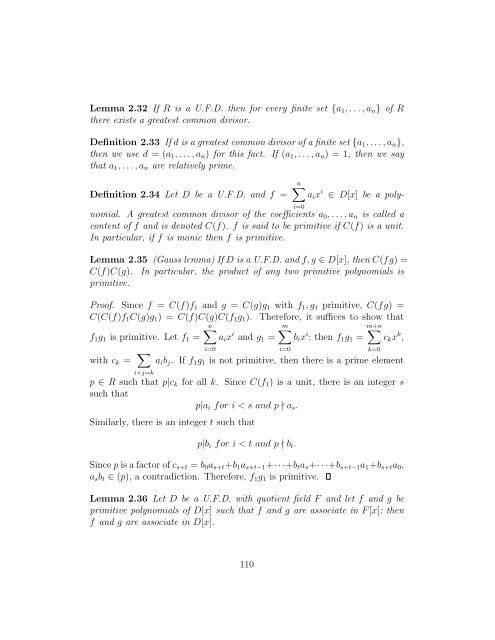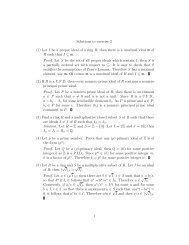Topics in algebra Chapter IV: Commutative rings and modules I - 1
Topics in algebra Chapter IV: Commutative rings and modules I - 1
Topics in algebra Chapter IV: Commutative rings and modules I - 1
Create successful ePaper yourself
Turn your PDF publications into a flip-book with our unique Google optimized e-Paper software.
Lemma 2.32 If R is a U.F.D. then for every f<strong>in</strong>ite set {a1, . . . , an} of R<br />
there exists a greatest common divisor.<br />
Def<strong>in</strong>ition 2.33 If d is a greatest common divisor of a f<strong>in</strong>ite set {a1, . . . , an},<br />
then we use d = (a1, . . . , an) for this fact. If (a1, . . . , an) = 1, then we say<br />
that a1, . . . , an are relatively prime.<br />
Def<strong>in</strong>ition 2.34 Let D be a U.F.D. <strong>and</strong> f =<br />
n<br />
aix i ∈ D[x] be a poly-<br />
nomial. A greatest common divisor of the coefficients a0, . . . , an is called a<br />
content of f <strong>and</strong> is denoted C(f). f is said to be primitive if C(f) is a unit.<br />
In particular, if f is monic then f is primitive.<br />
Lemma 2.35 (Gauss lemma) If D is a U.F.D. <strong>and</strong> f, g ∈ D[x], then C(fg) =<br />
C(f)C(g). In particular, the product of any two primitive polynomials is<br />
primitive.<br />
Proof. S<strong>in</strong>ce f = C(f)f1 <strong>and</strong> g = C(g)g1 with f1, g1 primitive, C(fg) =<br />
C(C(f)f1C(g)g1) = C(f)C(g)C(f1g1). Therefore, it suffices to show that<br />
n<br />
f1g1 is primitive. Let f1 = aix i m<br />
<strong>and</strong> g1 = bix i m+n <br />
; then f1g1 = ckx k ,<br />
with ck = <br />
i+j=k<br />
i=0<br />
i=0<br />
i=0<br />
k=0<br />
aibj. If f1g1 is not primitive, then there is a prime element<br />
p ∈ R such that p|ck for all k. S<strong>in</strong>ce C(f1) is a unit, there is an <strong>in</strong>teger s<br />
such that<br />
p|ai for i < s <strong>and</strong> p ∤ as.<br />
Similarly, there is an <strong>in</strong>teger t such that<br />
p|bi for i < t <strong>and</strong> p ∤ bt.<br />
S<strong>in</strong>ce p is a factor of cs+t = b0as+t+b1as+t−1+· · ·+btas+· · ·+bs+t−1a1+bs+ta0,<br />
asbt ∈ (p), a contradiction. Therefore, f1g1 is primitive.<br />
Lemma 2.36 Let D be a U.F.D. with quotient field F <strong>and</strong> let f <strong>and</strong> g be<br />
primitive polynomials of D[x] such that f <strong>and</strong> g are associate <strong>in</strong> F [x]; then<br />
f <strong>and</strong> g are associate <strong>in</strong> D[x].<br />
110



